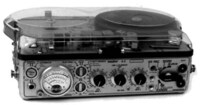 After the production tracks had been recorded in the field, the ¼-inch audiotape (such as from a Nagra) were sent back to the lab or studio for transfer to either 16mm or 35mm sprocketed magnetic film. This initial transfer was a critical stage for the audio (and the person who recorded it), since a poor transfer could easily induce lots of distortion.
After the production tracks had been recorded in the field, the ¼-inch audiotape (such as from a Nagra) were sent back to the lab or studio for transfer to either 16mm or 35mm sprocketed magnetic film. This initial transfer was a critical stage for the audio (and the person who recorded it), since a poor transfer could easily induce lots of distortion.
Sound for film – How it used to be done in the days of analog recording
An editor would then sync up the dailies, by aligning the clapsticks on both picture and sound and matching the lengths of the two reels (either adding leader or cutting out garbage). After the dailies had been synced, both picture and sound reels then had matching edge number codes inked on so as to facilitate keeping track of sync later on during editing. (Coding step could occur after the screening of dailies.)
Each previous day's footage would be screened in sync at the "dailies." Here, the producer, director, client, and key crew members got to evaluate what was shot. It was in this projection room that we got to "live or die".
Even today, It is very important for the sound mixer to attend at least the first few dailies screenings (if not all of them) in order to ascertain that the production tracks are not being played back distorted due to bad transfer or poor screening room facilities!
From there, the picture and production soundtracks went to the picture editor for rough cut.
After the completion of the rough cut, the material was duped. The picture editor kept the original edited workprint and a dupe of the production soundtrack. The sound editor received a dupe of the edited workprint and the original of the spliced production soundtrack for sound editing.
The sound editor performed several tasks to the sound. The dialogue of each main character was separated and spliced onto individual tracks so as to facilitate the final mixdown.
In fact, all of the sound elements (dialogue, effects, music, narration) were eventually checkerboarded onto separate tracks. This permits the dubbing mixers to establish individual volume levels and equalization for each track, and are thus able to deal precisely with overlaps, fades, special effects, and any changes that occur end to end with each other.
Unwanted ambiance occurring on the same track (such as between an actor's words) are cut out. This editing process is known as "flipping the track", because in 35mm that was literally what they did. Since 35mm has sprocket holes top and bottom, the editor merely had to invert the unwanted section so that the base side went where the (sound) magnetic emulsion was, and vice versa. In 16mm, they used leader.
Sounds of very short duration were merely erased from the track by mechanically removing some of the magnetic oxide emulsion with a razor blade, sandpaper, or cleaning solvent.
Totally unusable dialogue was replaced with A.D.R. (or the protection tracks, if suitable)
In the course of dialogue editing, the sound editors often came across a section that was full of unnecessary splices or contains damaged sprocket holes. Requests were sent to the Sound Department or lab to have these takes retransferred from the original ¼-inch tapes. These reprints werel then meticulously spliced in to replace the damaged sections.
This is why all transfers must be done to industry standard on well maintained equipment - so that reprints intermatch with original. Even in today's digital domain, consistency of recording levels and other settings are crucial; never forget to record a reference headtone at the beginning of each batch of audio files.
Sound effects were added wherever necessary, including the creation of ambient backgrounds. Foley was recorded for the footsteps, body movements, and some sync sound effects.
Narration tracks got laid in, as needed. Checkerboarding was used so that the mixers could correct any audible changes that may occur when different sounding takes were joined end to end.
Finally, music editors assembled the music tracks, cutting them to match the appropriate picture sections in terms of length, climax, and fade points. As with dialogue and effects, the music tracks were checkerboarded for the mix.
When we compare that olde process to the nonlinear digital editing systems in use today, we find that most of the creative tasks remain the same; it is just the physical drudgery of tape handling that has been streamlined. The computers can do it all, without the editor having to deal with reels of tape, mag stock, and workprint. But the principles behind the workflow really haven't changed that much.
